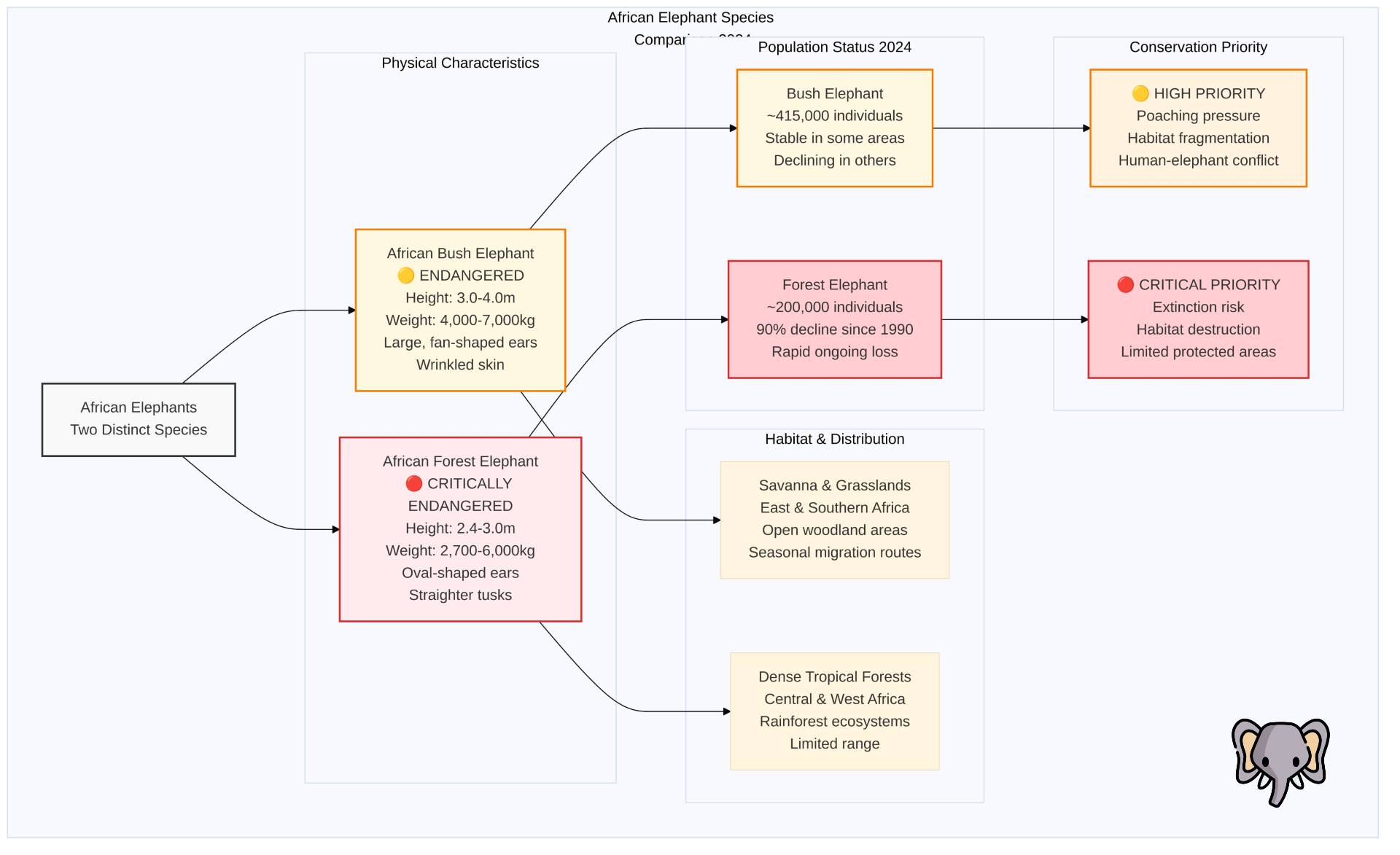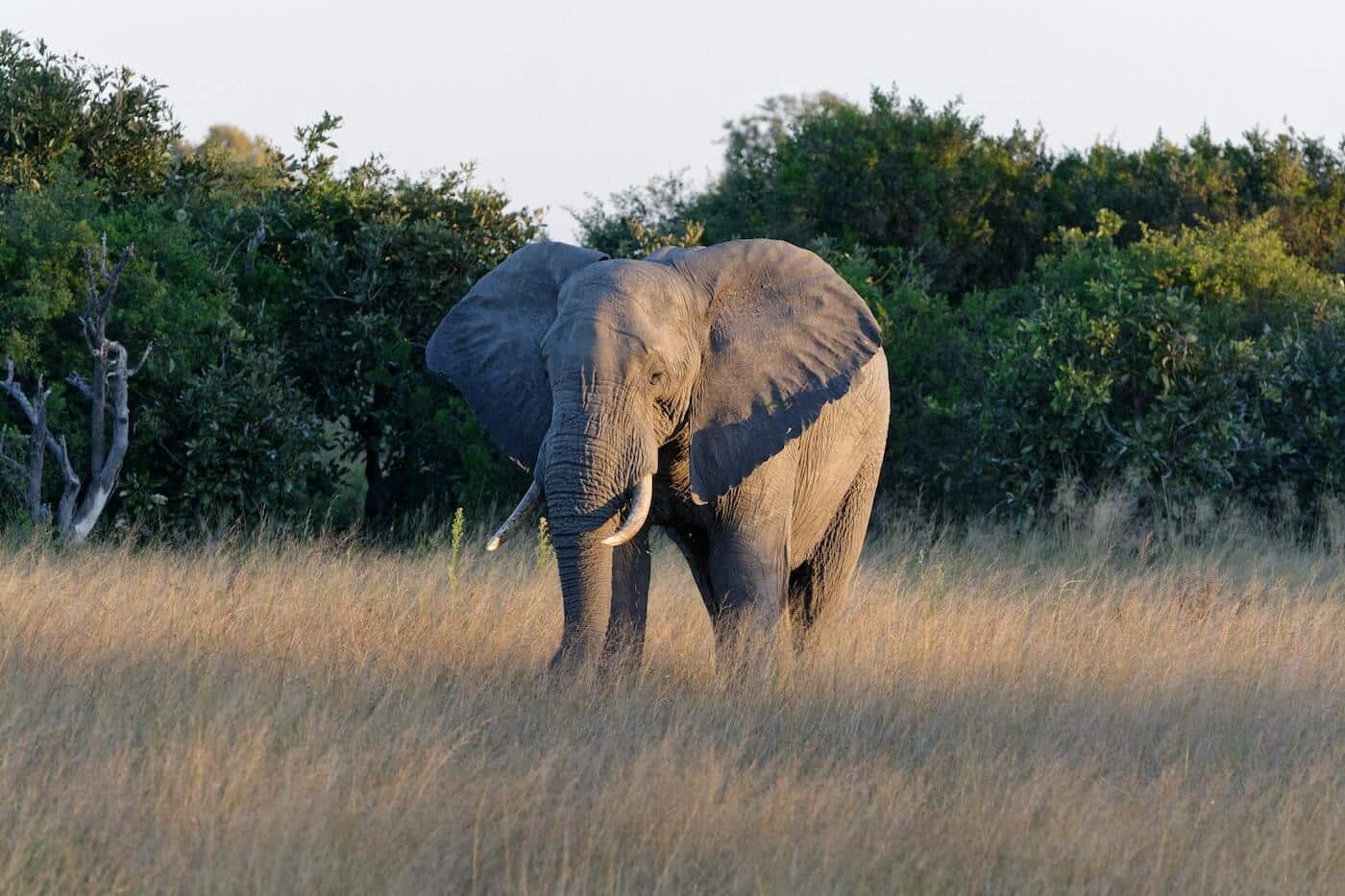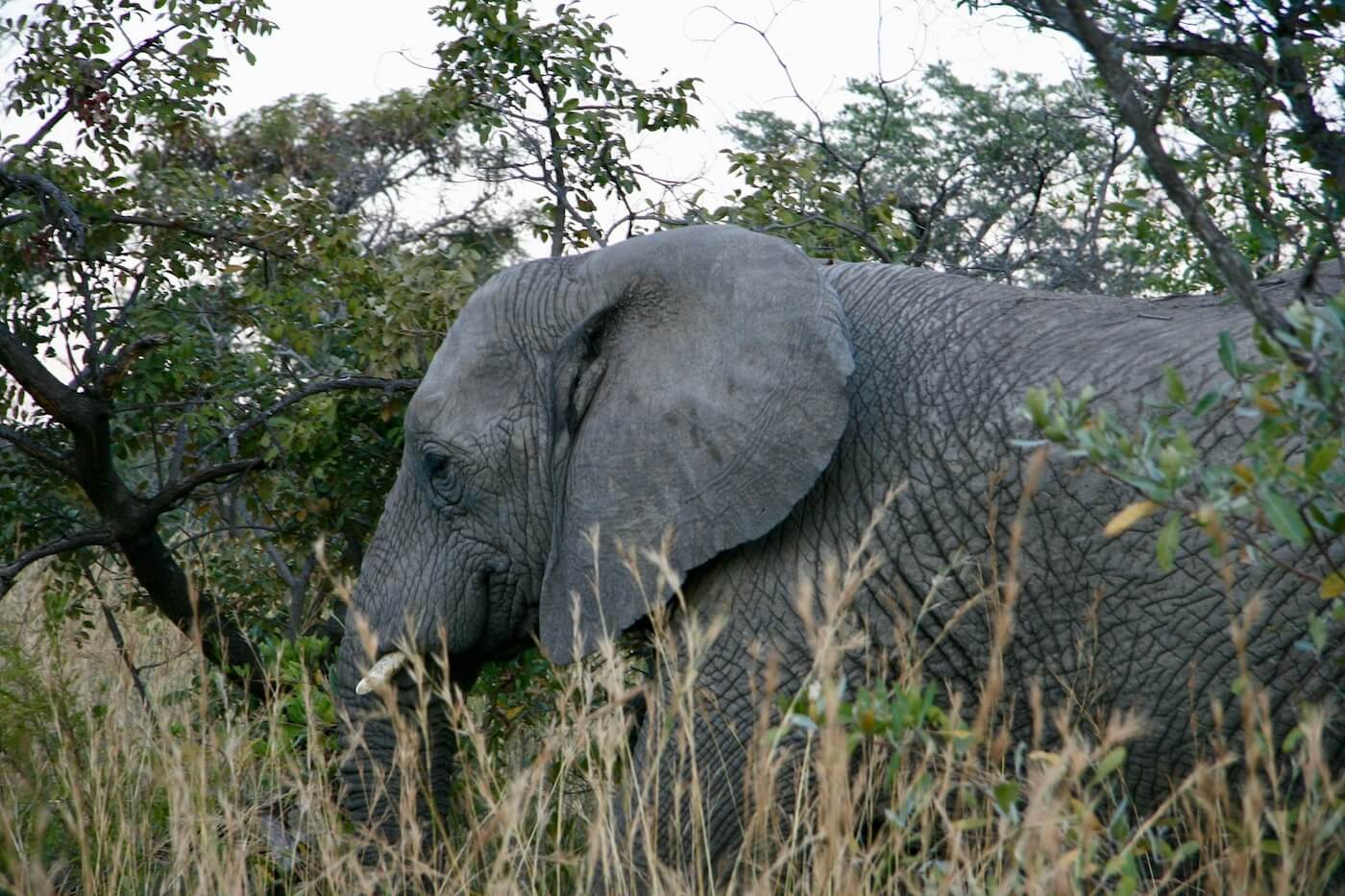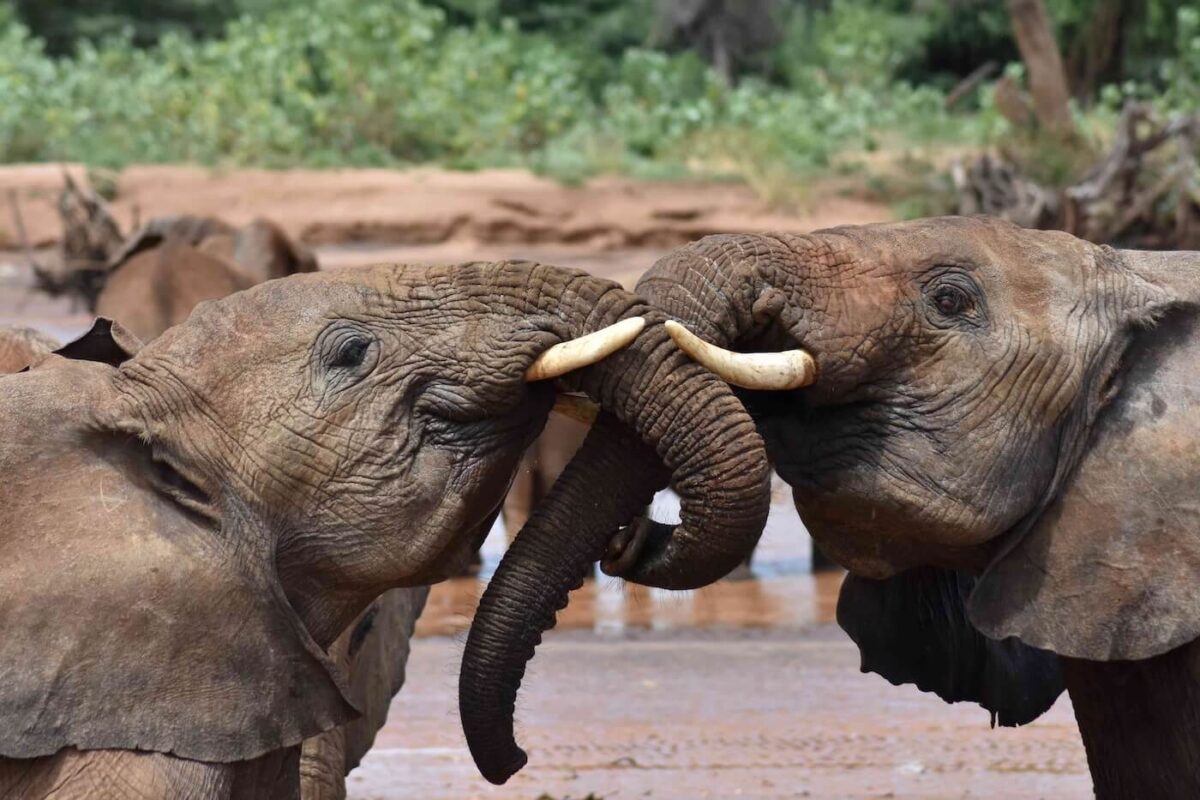Recente studies onthullen een catastrofale 90% afname van bosolifantenpopulaties sinds 1990Dit benadrukt de dringende behoefte aan soortspecifieke beschermingsstrategieën.
Decennialang beschouwden wetenschappers en liefhebbers van wilde dieren Afrikaanse olifanten als één soort. Baanbrekend genetisch onderzoek heeft echter aangetoond dat er in Afrika twee verschillende olifantensoorten leven: de Afrikaanse bosolifant (Loxodonta africana) en de Afrikaanse bosolifant (Loxodonta cyclotis). Dit onderscheid, dat in 2010 officieel werd erkend door de IUCN, heeft ons inzicht in de evolutie, het gedrag en de behoeften van olifanten op het gebied van natuurbehoud radicaal veranderd.
De verschillen tussen deze twee soorten reiken veel verder dan hun leefgebieden. Van de massieve bosolifanten die door de savannes van Oost-Afrika zwerven tot de kleinere, meer ongrijpbare bosolifanten die door de dichte regenwouden van Centraal- en West-Afrika navigeren, elke soort heeft unieke kenmerken ontwikkeld die een weerspiegeling zijn van miljoenen jaren aanpassing aan hun respectieve omgevingen.
Voor liefhebbers van wilde dieren Afrikaanse olifanten bekijken plannenInzicht in deze verschillen tussen soorten is cruciaal voor het kiezen van bestemmingen, het plannen van bezoeken en het waarderen van de opmerkelijke diversiteit binnen Afrikaanse olifantenpopulaties.
De seizoenspatronen die bepalend zijn voor de bewegingen van olifanten verschillen enorm per soort, waardoor soortspecifieke kennis essentieel is voor het succesvol bekijken van wilde dieren.

Herkenning van soorten en wetenschappelijke classificatie
De erkenning van twee verschillende Afrikaanse olifantensoorten is een van de belangrijkste ontwikkelingen in het moderne olifantenonderzoek. Deze classificatie kwam voort uit uitgebreide genetische studies die fundamentele verschillen tussen bos- en oerwoudpopulaties aan het licht brachten.
Genetisch bewijs voor de scheiding van soorten
Geavanceerde DNA-analyse heeft aangetoond dat Afrikaanse bos- en bosolifanten genetisch net zo verschillend zijn als Aziatische olifanten van mammoeten.
Onderzoek gepubliceerd in Nature toont aan dat deze soorten ongeveer 2,6 miljoen jaar geleden divergeerden en zich langs verschillende evolutionaire paden ontwikkelden die resulteerden in verschillende fysieke, gedrags- en ecologische kenmerken.
Belangrijkste genetische bevindingen:
- Chromosomale verschillen: Bosolifanten hebben 28 chromosomen, terwijl bosolifanten 30 chromosomen hebben.
- Mitochondriaal DNA: Onderscheiden lijnen die wijzen op afzonderlijke evolutionaire geschiedenissen
- Nucleaire genoomanalyse: Bevestigt genetische divergentie op soortniveau
- Hybridisatiestudies: Beperkte kruising in overlapzones produceert steriele nakomelingen
Dr. Alfred Roca, een geneticus aan de Universiteit van Illinois die heeft bijgedragen aan de baanbrekende genetische studies, legt uit: "Het genetische bewijs toont duidelijk aan dat Afrikaanse bos- en bosolifanten verschillende soorten zijn die zich miljoenen jaren lang apart hebben ontwikkeld."
Taxonomische geschiedenis en erkenning
De weg naar de erkenning van de soort vergde tientallen jaren van onderzoek en wetenschappelijk debat:
Historische classificatie (1900-2000): Beide populaties beschouwd als ondersoorten van Loxodonta africana Genetische Revolutie (2000-2010): DNA-studies onthullen verschillen op soortsniveau Officiële erkenning (2010): IUCN erkent formeel twee verschillende soorten Impact op behoud (2010-heden): Soortspecifieke beschermingsstrategieën ontwikkeld.

Afrikaanse bosolifant: Reuzen van de savanne
Afrikaanse bosolifanten (Loxodonta africana) zijn 's werelds grootste landzoogdieren, perfect aangepast aan het leven in de uitgestrekte savannes, graslanden en semi-aride gebieden van Afrika.
Deze prachtige dieren belichamen het klassieke beeld van Afrikaanse olifanten, met hun indrukwekkende afmetingen en iconische silhouetten tegen de Afrikaanse zonsondergang.
Fysieke kenmerken en aanpassingen
Volwassen mannelijke bosolifanten meten meestal 3,0 tot 4,0 meter op de schouder en wegen tussen de 4.000 en 7.000 kilogram.
De grootste geregistreerde bosolifant, die in 1974 in Angola werd geschoten, woog naar schatting 10.000 kilo en was 4,2 meter lang bij de schouder.
Onderscheidende kenmerken:
- Enorme oren: Waaiervormige oren die tot 2 meter in diameter kunnen zijn
- Gerimpelde huid: Diepe huidplooien die de oppervlakte voor koeling vergroten
- Rechte slagtanden: Zowel mannetjes als vrouwtjes ontwikkelen slagtanden.
- Concave rug: Onderscheidend gebogen rugprofiel
- Kenmerken van de stam: Twee vingerachtige uitsteeksels aan het uiteinde van de romp
Aanpassingen aan de savanne
Bosolifanten hebben zich op allerlei manieren aangepast aan het leven in een open savanneomgeving:
Thermoregulatie: Grote oren en uitgebreide huidplooien helpen warmte af te voeren in hete, open omgevingen waar schaduw beperkt is.
Waterbesparing: Dankzij een efficiënte nierfunctie en gedragsaanpassingen kunnen ze overleven in semi-aride omstandigheden met beperkte waterbronnen.
Voedingsstrategieën: Door hun veelzijdige voedingsgedrag kunnen ze verschillende plantenbronnen benutten, van grassen tijdens natte seizoenen tot schors en wortels tijdens droge perioden.
Migratiepatronen: Seizoensgebonden bewegingen volgen regenval en vegetatiepatronen en leggen soms honderden kilometers per jaar af.
Verspreiding en habitat
Struikolifanten leven in verschillende ecosystemen in Afrika ten zuiden van de Sahara, waarbij de grootste populaties geconcentreerd zijn in Oost- en Zuidelijk Afrika.
Primaire habitats:
- Savannes en graslanden: Open bossen en graslanden van Oost-Afrika
- Semi-aride gebieden: Kalahari-woestijnranden en vergelijkbare omgevingen
- Savannebossen: Gemengde boom-gras ecosystemen
- Uiterwaarden: Seizoensgebonden wetlands en riviersystemen
Huidig bereik:
- Botswana: ~130.000 olifanten (grootste populatie)
- Zimbabwe: ~85.000 olifanten
- Tanzania: ~60.000 olifanten
- Kenia: ~35.000 olifanten
- Zambia: ~27.000 olifanten
Beschermingsstatus en populatietrends
Afrikaanse bosolifanten worden door de IUCN geclassificeerd als bedreigd, met populaties die afnemen als gevolg van meerdere bedreigingen. Hun beschermingsstatus varieert echter aanzienlijk binnen hun verspreidingsgebied.
Bevolkingstrends:
- Algehele afname: 60% afname van de populatie sinds 1979
- Regionale variaties: Sommige populaties stabiel of toenemend (Botswana, delen van Zimbabwe)
- Gevolgen van stroperij: Naar schatting 20.000-30.000 olifanten worden jaarlijks gedood voor ivoor.
- Verlies van habitat: Uitbreiding van de landbouw vermindert de beschikbare habitat
Successen op het gebied van natuurbehoud: Het Kavango-Zambezi Transfrontier Conservation Area (KAZA) is een groot succes op het gebied van natuurbehoud. Het beschermt de migratieroutes van olifanten in vijf landen en ondersteunt de grootste olifantenpopulatie ter wereld.
Toerisme en kijkmogelijkheden
Olifanten in de bush bieden spectaculaire kijkmogelijkheden op talloze Afrikaanse bestemmingen. begrijpen seizoensgebonden olifantenkijkpatronen vergroot de kans op onvergetelijke ontmoetingen en ondersteunt tegelijkertijd natuurbehoud door verantwoord toerisme.
Topbestemmingen:
- Botswana: Chobe Nationaal Park en Okavango Delta
- Tanzania: Nationale parken Serengeti en Tarangire
- Kenia: Nationale parken Amboseli en Tsavo
- Zimbabwe: Hwange Nationaal Park
- Zuid-Afrika: Kruger Nationaal Park
Optimale kijkseizoenen:
- Droog seizoen (mei-oktober): Olifanten concentreren zich rond waterbronnen
- Migratieperioden: Spectaculaire kuddes verplaatsen zich tussen seizoensgebieden
- Kalftijd (november-maart): Mogelijkheden om familiedynamiek te observeren


Afrikaanse bosolifant: De tuiniers van het regenwoud
Afrikaanse bosolifanten (Loxodonta cyclotis) behoren tot de meest bedreigde grote zoogdieren ter wereld en spelen een cruciale rol als "ecosysteemingenieurs" in Centraal- en West-Afrikaanse regenwouden.
Deze kleinere, meer ongrijpbare olifanten hebben zich opmerkelijk aangepast aan het leven in dichtbegroeide bosgebieden.
Fysieke kenmerken en aanpassingen aan het bos
Volwassen mannelijke bosolifanten meten meestal 2,4 tot 3,0 meter (7,9 tot 9,8 voet) op de schouder en wegen tussen 2.700 en 6.000 kilogram (6.000 tot 13.200 pond).
Hoewel ze kleiner zijn dan hun verwanten op de savanne, hebben bosolifanten unieke aanpassingen die hen perfect geschikt maken voor het leven in het regenwoud.
Onderscheidende kenmerken:
- Kleinere, ovaalvormige oren: Beter geschikt voor navigatie door dichte vegetatie
- Rechtere, naar beneden gerichte slagtanden: Aangepast voor foerageren op de bosgrond en verdediging
- Donkere huidskleur: Biedt camouflage in bosrijke omgevingen
- Meer rechthoekige lichaamsvorm: Lager profiel om door dicht struikgewas te bewegen
- Hardere, dichtere botten: Structurele aanpassingen voor bosterrein
Ecologische rol als bosbouwers
Bosolifanten zijn cruciale ecosysteemingenieurs die de structuur van het regenwoud en de biodiversiteit vormgeven door hun voedings- en bewegingspatronen.
Zaadverspreiding: Bosolifanten verspreiden zaden van meer dan 350 plantensoorten, waarbij ze tot wel 60 kilometer afleggen voordat ze de zaden in voedselrijke mest deponeren. Deze langeafstandsverspreiding is essentieel voor het behoud van genetische diversiteit in bosplantenpopulaties.
Bosstructuur: Door het voederen van olifanten ontstaan open plekken en worden bospaden onderhouden waar talrijke andere soorten van profiteren. Hun selectief snoeien beïnvloedt de samenstelling van het bos en de successiepatronen.
Koolstofopslag: Door de groei van grote, langzaam groeiende bomen te bevorderen door selectief te eten, dragen bosolifanten bij aan de koolstofvastlegging in tropische bossen.
Dr. Andrea Turkalo, die al meer dan 20 jaar bosolifanten bestudeert in Dzanga Bai, merkt op: "Bosolifanten zijn de architecten van het regenwoud. Hun verdwijning zou deze ecosystemen fundamenteel veranderen op manieren die we nu pas beginnen te begrijpen."
Kritieke staat van instandhouding
Bosolifanten worden geconfronteerd met een uitsterfcrisis, met populaties die sinds 1990 met meer dan 90% zijn afgenomen. De soort is geclassificeerd als ernstig bedreigd, een van de ernstigste noodsituaties voor het behoud van grote zoogdieren.
Catastrofale achteruitgangsfactoren:
- Crisis door stroperij: ivoor met hoge waarde drijft intensieve stroperijdruk op
- Vernietiging van habitats: Houtkap en landbouwomschakeling vernietigen boshabitat
- Burgerconflict: Politieke instabiliteit in landen in het verspreidingsgebied belemmert inspanningen voor natuurbehoud
- Lage voortplantingssnelheid: Langzame voortplanting maakt herstel van populatie extreem moeilijk
Recente populatiestudies: Een uitgebreid onderzoek uit 2024, gepubliceerd in Conservation Biology, documenteerde de omvang van de afname van de bosolifant:
- Centraal-Afrikaanse Republiek: 95% bevolkingsdaling sinds 1990
- Kameroen: 80% afname in grote bosreservaten
- Gabon: 70% achteruitgang ondanks status beschermd gebied
- Democratische Republiek Congo: Populaties gefragmenteerd en kritisch laag
Overgebleven bolwerken
Ondanks de crisis zijn er in verschillende gebieden nog levensvatbare bosolifantenpopulaties:
Belangrijke beschermde gebieden:
- Sangha Trinational (Kameroen/CAR/Congo): UNESCO werelderfgoed
- Nationaal park Odzala-Kokoua (Congo): Groot intact bosecosysteem
- Nationaal park Lopé (Gabon): Gemengd bos-savanna habitat
- Dzanga-Sangha (Centraal-Afrikaanse Republiek): Beroemd om bosontginningen
Inspanningen voor natuurbehoud en internationale respons
De crisis rond de bosolifant heeft geleid tot ongekende internationale inspanningen voor natuurbehoud:
Initiatieven tegen stroperij: Maatschappij voor het behoud van wilde dieren leidt de strijd tegen stroperij in Centraal-Afrika, traint lokale rangers en levert uitrusting om olifanten te beschermen.
Bescherming van habitats: WWF ondersteunt de oprichting en het beheer van grensoverschrijdende beschermde gebieden die een kritieke bosolifantenhabitat in stand houden.
Betrokkenheid van de gemeenschap: Lokale gemeenschappen krijgen training en werk in natuurbeschermingsactiviteiten, waardoor er economische stimulansen ontstaan om olifanten te beschermen.
Internationale handelscontroles: De CITES-regelgeving is bedoeld om de vraag naar ivoor te verminderen, maar de handhaving blijft een uitdaging.
Beperkte toeristische mogelijkheden
De mogelijkheden om olifanten in het bos te bekijken zijn beperkt, maar bieden unieke ervaringen voor toegewijde liefhebbers van wilde dieren:
Aanbevolen lectuur: De beste bestemmingen ter wereld om olifanten in het wild te zien
Locaties bekijken:
- Dzanga Bai (CAR): Boskap waar olifanten zich verzamelen om toegang te krijgen tot mineralen
- Langoué Bai (Gabon): Afgelegen open plek in het bos bereikbaar per boot
- Odzala (Congo): Boswandelingen met gids en bai bezoeken
Uitdagingen bekijken:
- Dichte vegetatie: Beperkte zichtbaarheid in bosrijke omgevingen
- Ongrijpbaar gedrag: Bosolifanten zijn meer op hun hoede voor mensen
- Toegangsmoeilijkheden: Afgelegen locaties vereisen gespecialiseerde logistiek
- Veiligheidsproblemen: Politieke instabiliteit beïnvloedt sommige gebieden in het verspreidingsgebied
Soorten vergelijken: De verschillen begrijpen
De verschillen tussen Afrikaanse bos- en bosolifanten strekken zich uit over meerdere biologische en ecologische dimensies en weerspiegelen miljoenen jaren van afzonderlijke evolutie.
Fysieke vergelijkingstabel
| Kenmerk | Bosolifant | Bosolifant |
|---|---|---|
| Lengte (mannen) | 3,0-4,0 m (10-13 ft) | 2,4-3,0 m (7,9-9,8 ft) |
| Gewicht (mannen) | 4.000-7.000 kg | 2.700-6.000 kg |
| Vorm oor | Groot, waaiervormig | Kleiner, ovaal |
| Tusk Richting | Naar buiten gebogen | Recht, omlaag |
| Huidskleur | Lichter grijs | Donkerder grijsbruin |
| Lichaamsprofiel | Concave rug | Meer rechthoekig |
Gedrags- en ecologische verschillen
Sociale structuur:
- Bosolifanten: Grote kuddes van 8-100 individuen
- Bosolifanten: Kleinere groepen van 2-8 individuen
Voedingsgedrag:
- Bosolifanten: Grazers en browsers, seizoensgebonden variatie in het dieet
- Bosolifanten: Voornamelijk browsers, fruitspecialisten
Bewegingspatronen:
- Bosolifanten: Seizoensmigraties over lange afstanden
- Bosolifanten: Kleinere leefgebieden, netwerken van bospaden
Communicatie:
- Bosolifanten: Infrasone langeafstandsgesprekken in open landschappen
- Bosolifanten: Aangepaste oproepen voor akoestische bosomgevingen
Implicaties voor behoud
De erkenning van twee verschillende soorten heeft ingrijpende gevolgen voor beschermingsstrategieën:
Soortspecifieke bedreigingen:
- Bosolifanten: Versnippering van habitats, conflicten tussen mens en dier
- Bosolifanten: Intensieve stroperij, vernietiging habitat
Prioriteiten voor instandhouding:
- Bosolifanten: Corridorbescherming, coëxistentie van gemeenschappen
- Bosolifanten: Stropers bestrijden, habitat behouden
Toewijzing van financiering:
- Bosolifanten: Beheer van populaties, ontwikkeling van toerisme
- Bosolifanten: Noodinterventie, wetshandhaving
Het plannen van je Afrikaanse Olifantenervaring
Inzicht in de verschillen tussen soorten verbetert de kijkervaring van wilde dieren en ondersteunt het behoud door geïnformeerde toeristische keuzes.
Je bestemming kiezen
Voor het bekijken van bosolifanten:
- Beste algemene ervaring: Botswana (Chobe/Okavango)
- Grote migratie: Tanzania (Tarangire/Serengeti)
- Fotografische mogelijkheden: Kenia (Amboseli)
- Budgetvriendelijk: Zuid-Afrika (Kruger)
Voor het bekijken van bosolifanten:
- Meest toegankelijk: Gabon (nationaal park Lopé)
- Unieke ervaring: CAR (Dzanga Bai) - als de veiligheid het toelaat
- Onderzoeksmogelijkheden: Congo (Odzala-Kokoua)
Seizoensgebonden overwegingen
Struik Olifant Optimale Tijden:
- Droog seizoen (mei-oktober): Geconcentreerd rond waterbronnen
- Vroeg droog seizoen (mei-juli): Beste weersomstandigheden
- Laat droog seizoen (augustus-oktober): Hoogste dichtheden olifanten
Bosolifant overwegingen:
- Droog seizoen (december-maart): Betere toegang tot open plekken in het bos
- Nat seizoen (april-november): Uitdagender maar authentieke ervaring
Vooruitzichten voor behoud en uitdagingen voor de toekomst
De toekomst van de Afrikaanse olifant hangt af van de aanpak van soortspecifieke instandhoudingsproblemen, terwijl de ecologische integriteit van hun leefgebieden behouden blijft.
Prioriteiten voor het behoud van de bosolifant
Verbondenheid van habitats: Het beschermen van migratiecorridors en seizoensgebonden gebieden over internationale grenzen heen blijft van cruciaal belang voor het behoud van levensvatbare bosolifantenpopulaties.
Conflict tussen mens en wild: Ontwikkeling van duurzame coëxistentiestrategieën naarmate menselijke populaties zich uitbreiden naar het traditionele olifantengebied.
Toerisme in balans: De druk van het toerisme beheren en tegelijkertijd de voordelen voor het behoud en de steun van de gemeenschap maximaliseren.
Bosolifant noodhulp
Intensivering van stroperij: Onmiddellijke actie vereist om de stroperijcrisis te stoppen voordat de olifantenpopulaties in het bos volledig instorten.
Bescherming van habitats: Het behoud van resterende intacte bosecosystemen en het creëren van beschermde corridors tussen gefragmenteerde populaties.
Internationale samenwerking: Gecoördineerde inspanningen tussen staten in het verspreidingsgebied om grensoverschrijdende instandhoudingsproblemen aan te pakken.
Implicaties van klimaatverandering
Beide soorten staan voor extra uitdagingen door de klimaatverandering:
Bosolifanten: Veranderende neerslagpatronen kunnen traditionele migratieroutes en de beschikbaarheid van water veranderen.
Bosolifanten: De veranderende samenstelling en structuur van bossen kan invloed hebben op voedselbronnen en geschiktheid van habitats.
Conclusie: Twee soorten, één beschermingsmissie
De erkenning van de Afrikaanse bos- en bosolifanten als aparte soorten heeft een revolutie teweeggebracht in ons begrip van de diversiteit van olifanten en de behoeften op het gebied van natuurbehoud.
Hoewel bosolifanten voor grote uitdagingen staan, blijven hun populaties in sommige regio's relatief stabiel. Bosolifanten worden echter geconfronteerd met een acute uitsterfcrisis die vraagt om dringende wereldwijde actie.
Voor liefhebbers van wilde dieren vergroot het begrip van deze verschillen de waardering voor de diversiteit van olifanten en ondersteunt het meer weloverwogen keuzes op het gebied van natuurbehoud. Of je nu getuige bent van de spectaculaire bijeenkomsten van bosolifanten in het Chobe National Park in Botswana of het zeldzame voorrecht hebt om bosolifanten te observeren in de regenwouden van Centraal-Afrika, elke ontmoeting draagt bij aan de bredere missie van het behoud van olifanten.
De toekomst van beide soorten hangt af van onze gezamenlijke inzet om hun leefgebieden te beschermen, lokale gemeenschappen te ondersteunen en de onderliggende oorzaken van de achteruitgang van olifanten aan te pakken. Door verantwoord toerisme, steun voor natuurbehoud en voortdurend onderzoek kunnen we ervoor zorgen dat toekomstige generaties de kans krijgen om getuige te zijn van de grootsheid van beide Afrikaanse olifantensoorten in hun natuurlijke leefomgeving.
Naarmate we meer over deze opmerkelijke dieren te weten komen, blijft één ding duidelijk: de diversiteit van de Afrikaanse olifanten weerspiegelt het ongelooflijke aanpassingsvermogen en de veerkracht van het leven op aarde. Het beschermen van beide soorten gaat niet alleen over het behoud van individuele populaties, maar ook over het behoud van de ecologische integriteit van Afrika's belangrijkste ecosystemen en over onze verantwoordelijkheid als rentmeesters van de natuurlijke wereld.
